

一、寻根100年前的宁波——逐步打开的国门
100 years ago in Ningbo—— The gradual opening of the country
当时中国正处于清朝末年,已经沦为了半殖民地半封建社会。政治方面,反动腐朽的晚清政府依然在挣扎。国际上遭受着帝国主义的瓜分与掠夺。中国被迫慢慢打开了国门,外国的资本侵略使得自然经济瓦解,民族资本主义的得到一定的发展同时也受到阻碍。文化上,传统的封建文化逐渐瓦解,西方文化慢慢传入中国。传教士、教堂、在宁波城区也慢慢发展建立。各种建筑反映着当时的传统与现代并存。
At that time, China was at the end of the Qing Dynasty and had become a semi colonial and semi feudal society. In politics, the reactionary and decadent late Qing government was still struggling. The world is suffering from the partition and plunder of imperialism. China was forced to open its door slowly. The invasion of foreign capital led to the collapse of natural economy, and the development of national capitalism was hindered at the same time. Culturally, the traditional feudal culture gradually disintegrated and the western culture gradually spread into China. Missionaries, churches were also gradually developed and established in Ningbo City.Various buildings reflect the coexistence of tradition and modernity at that time.
(一)宁波老外滩Ningbo Bund

1.景点介绍 Introduction
宁波老外滩,是坐落于浙江省宁波市三江口北岸江北区的一个港口。于1844年开埠,地处宁波市中心,位于甬江、奉化江和余姚江的三江汇流之地,唐宋以来就是最繁华的港口之一,曾是“五口通商”中最早的对外开埠区,是进入宁波古城的门户。建筑面积8万平方米的老外滩面积,囊括了个性消费的所有功能,包括城建展馆、国际酒店、世界美食、城市公寓、行业会馆、生活天地,一举成为宁波最顶级的社交平台,一个高档次、多元化的商业街区。
Ningbo Bund is a port located in Jiangbei District, North bank of Sanjiangkou, Ningbo City, Zhejiang Province. It was opened in 1844. It is located in the center of Ningbo, where the three rivers of Yongjiang, Fenghua and Yuyao converge. It has been one of the most prosperous ports since the Tang and Song dynasties. It was the earliest open port area among the "five ports" and the gateway to the ancient city of Ningbo. The Bund, with a building area of 80000 square meters, covers all the functions of individual consumption, including urban construction, exhibition hall, international hotel, world food, city apartment, industry hall and life world. It has become the top social platform in Ningbo and a high-grade and diversified business block.
沿着江边,外国领事馆、天主教堂、银行、轮船码头一字排开,几乎记录了宁波开埠的整段历史。这些建筑,至少有100多年历史。保存下来的文物建筑有:英国领事馆、巡捕房、侵华日军水上司令部、浙海关、天主教堂、江北耶稣圣教堂、宁波邮政局、通商银行等还有一些民房,如老“宏昌源号”、商人私宅“严氏山庄”、“朱宅”等建筑,这些建筑具有浓郁的欧陆风格,代表了英、法、德、荷等多国建筑风格。与中国传统民居形成鲜明对比。
Along the riverside, foreign consulates, Catholic churches, banks and ship docks line up, almost recording the whole history of Ningbo's opening. These buildings, at least 100 years old. The preserved cultural relics and buildings include the British Consulate, the patrol house, the Japanese water command, Zhejiang customs, the Catholic Church, the Jesuit Church in Jiangbei, Ningbo post office, Tongshang bank, etc. There are also some civil buildings, such as the old "hongchangyuan", the merchant's private house "Yan's Manor" and "Zhu's house". These buildings have a strong European style and represent Britain, France and Germany , Dutch and other architectural styles. It is in sharp contrast with traditional Chinese houses.
2.特色看点 Outstanding feature
(1)宁波近代商帮的起航地The starting place of Ningbo business gang
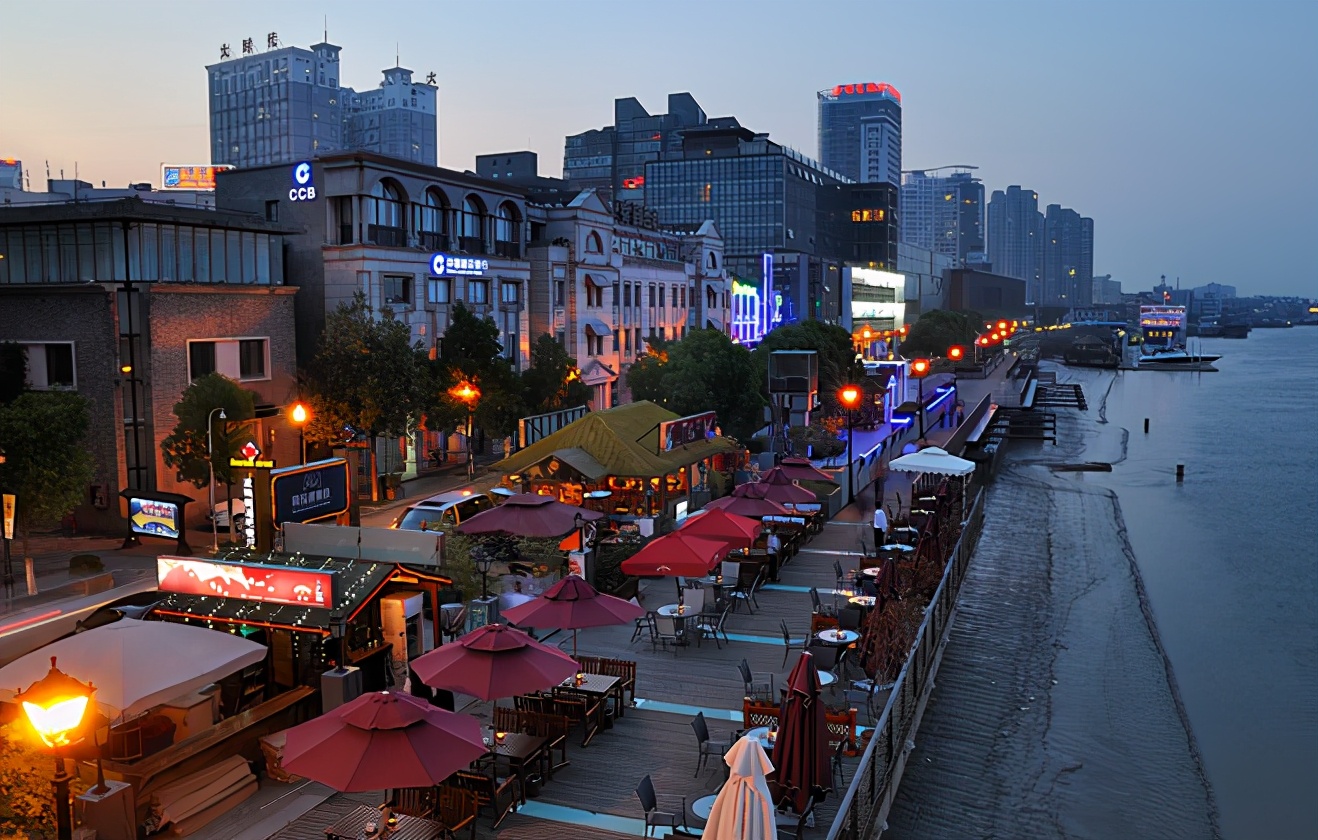
宁波的近代商帮利用外滩这一通商口岸所带来的发展机遇,利用身处当时中国对外开放前沿地带及对外贸易的先天优势,纷纷创办轮船公司,从事宁波至上海等地的运输,特别是从事当时颇有风险的对外经济活动,从而大大促进了宁波商帮的近代化进程。宁波外滩的54处文物建筑中至少有31处与宁波商帮有关。
The modern commercial groups in Ningbo took advantage of the development opportunities brought by the Bund, the trading port, and the inherent advantages of China's opening up to the outside world and foreign trade at that time to establish company. They set up shipping companies to engage in the transportation from Ningbo to Shanghai, especially the risky foreign economic activities at that time, which greatly promoted the modernization process of Ningbo commercial groups. There are at least 31 of the 54 cultural relics and buildings on the Bund of Ningbo are related to the Ningbo business gang.
(2)近代商业文化的展示区Exhibition area of modern commercial culture
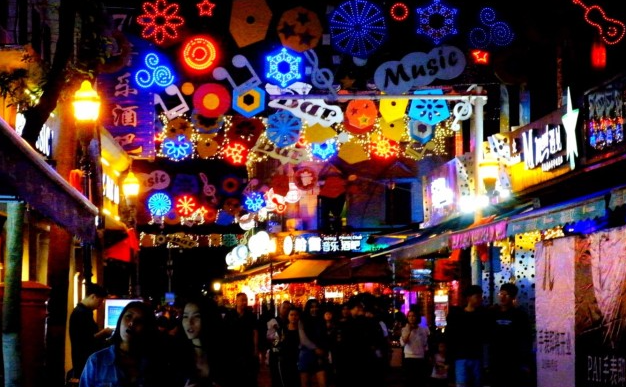
二十世纪二三十年代,外滩是宁波的商业中心。这是一个围绕港口而兴起的特色商业区。整个外滩区块可以分为三层,各街区的功能非常清晰:第一层是外马路生产作业区,第二层是中马路消费区,第三层是后马路居住区。
In the 1920s and 1930s, the Bund was the commercial center in Ningbo. This is a characteristic business district around the port. The whole Bund block can be divided into three layers, and the functions of each block are very clear: the first layer is the production and operation area of the outer Road, the second layer is the consumption area of the Middle Road, and the third layer is the residential area of the back road.
(3)近代新事物的实验场Experimental field of new things
近代宁波外滩是新观念、新事物不断萌芽,新旧观念不断碰撞的地方,吃穿住行玩乐等方面都浸润了西化的色彩,西式糕点、西洋电影、夜总会、舞厅等进入了当地百姓的生活,住洋楼、吃洋菜、点洋灯都成为了时尚。宁波的老百姓正是从外滩这一窗口看到了世界,接触了西方文明。
The Bund of Modern Ningbo is a place where new ideas and new things are constantly sprouting, where new and old ideas are constantly colliding. Western style pastry, western movies, nightclubs, dance halls, etc. have been infiltrated into the life of local people, and living in western style buildings, eating foreign vegetables, and lighting foreign lights have become a fashion at that time. It is from the Bund that the common people of Ningbo see the world and come into contact with Western civilization.
(4)近代富有开创性的教育中心A pioneering education center
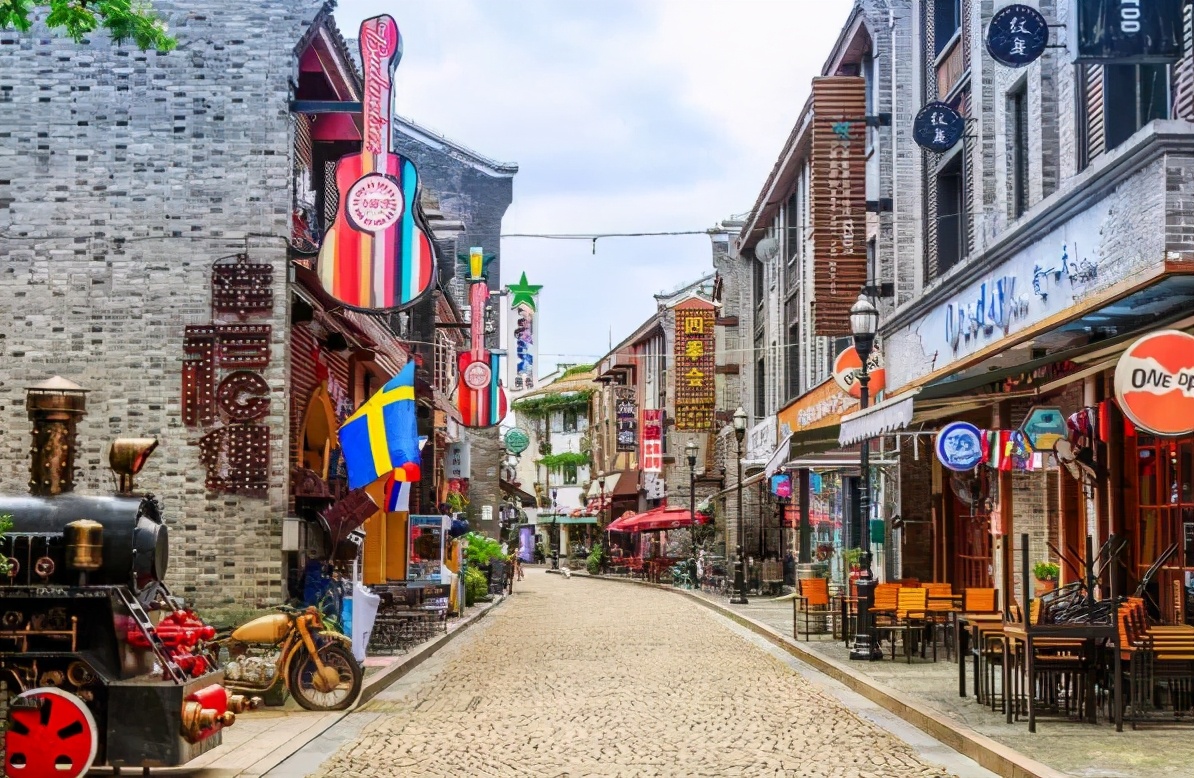
近代宁波外滩还是一个教育中心。像斐迪(宁波三江中学)、斐德、正始、毓才中学等都是当时最好的学校,教会为了笼络人心,在外滩一带相继办起了一批公益性的教育机。这些学校不仅吸纳了一批外国人充当老师,还把当时西方先进的教育理念渗透到了日常教学之中,当时许多生动的教育活动即使在现在看来,仍然有相当的借鉴意义。
The Bund of Modern Ningbo is also an educational center. Feidi (Ningbo Sanjiang middle school), Feide, Zhengshi, Yucai Middle School, etc. were all the best schools at that time. In order to attract people's hearts, the church set up a number of public welfare educational opportunities in the Bund area. These schools not only absorbed a group of foreigners as teachers, but also infiltrated the advanced western education ideas into the daily teaching. At that time, many vivid education activities, even at present, still have considerable reference significance.
(5)近代外来宗教的集散地The distribution center of foreign religions
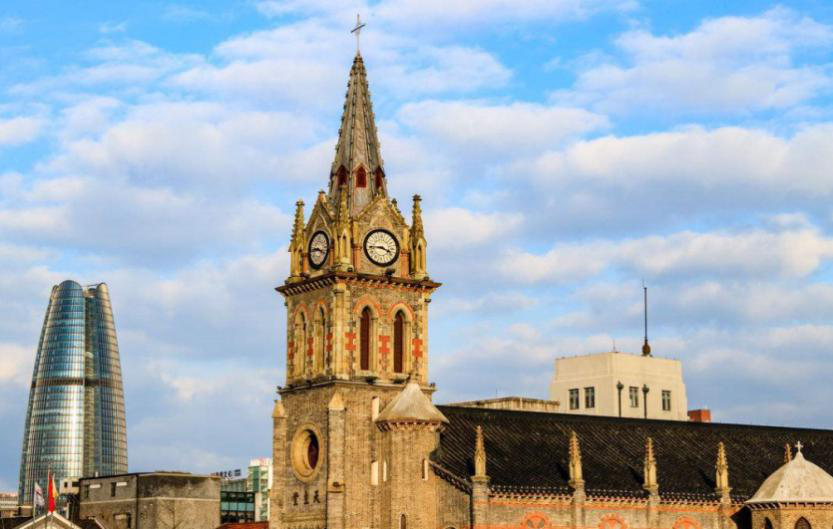
1844年1月1日,宁波五口通商开埠,指定江北岸为外国人通商居留地。1860年前后,外国领事、商人、教士、外侨侨眷等多数居住在江北岸槐花树下至桃花渡法国天主堂沿江一带。宁波外滩附近的宗教基本上是外来的,在这块区域内,修道院、耶稣堂、天主堂遍布。尚存的外来宗教的一个实物标志就是建于1872年的法国哥特式建筑———天主教堂,建筑面积4380平方米。
On January 1, 1844, the five ports of Ningbo were open for commerce, and the North Bank of the river was designated as the place of residence for foreigners. Around 1860, most foreign consuls, merchants, priests, overseas Chinese and their family members lived in the area along the river from Huaihua tree on the North Bank of the river to taohuadu French Catholic Church. The religions near the Bund of Ningbo are basically alien. In this area, monasteries, Jesuits and Catholic churches are all over it. One of the physical signs of the remaining foreign religions is the French Gothic building, the Catholic Church, built in 1872, with a building area of 4380 square meters.
3.历史文化 History and Culture
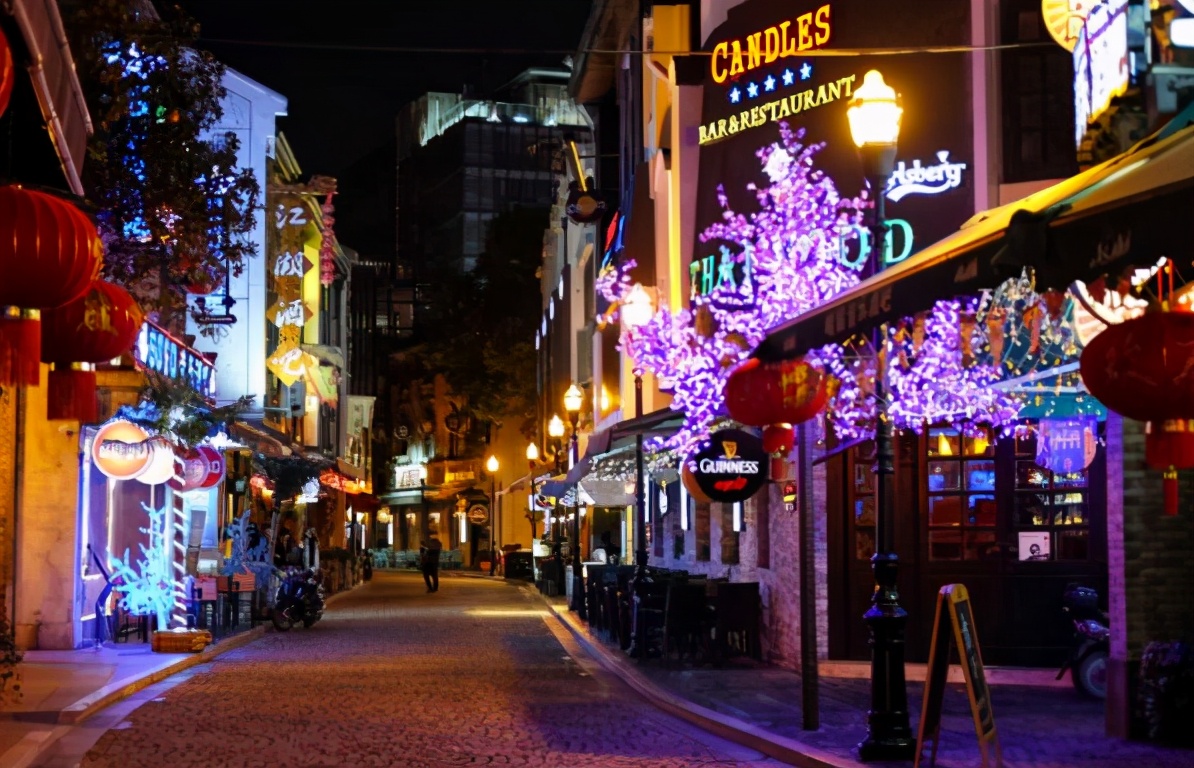
宁波在唐代即为中国四大港口之一,鉴真东渡的起始点就在宁波,在南宋时期为中国三大港口之一,并设立市舶司专门负责管理对外贸易的。虽然清政府一直采取闭关自守的对外政策,但宁波与日本、南洋各地一直保持着藕断丝连的贸易往来。在清代实行全面闭关之时,宁波却保留了对外贸易的特殊港口。这种特殊的港口地位从1644年到1684年左右,时间长达约40年。
Ningbo was one of China's four major ports in Tang Dynasty, the starting point of Jianzhen's eastward crossing was Ningbo, and it was one of China's three major ports in the Southern Song Dynasty, and a municipal shipping department was set up to manage foreign trade. Although the Qing government had always adopted a closed door foreign policy, Ningbo had always maintained trade relations with Japan and South Asia. In the Qing Dynasty, Ningbo kept a special port for foreign trade. From 1644 to about 1684, this special port status lasted for about 40 years.
宁波作为五口通商口岸之一,各国商人蜂拥至宁波,英、法等国采用夺取主权,建立据点,霸占海关、控制海口,垄断航运,推行洋化等一系列手段,把宁波港扭曲成半殖民地性质的港口。1844年正式开埠。不久,江北岸便发展成为英、法、美三国侨民居留区域。是中国最早的“租界”之一,历史上也称为“外滩”,其开埠历史比上海外滩还要早上20年,是中国最古老的外滩之一,在客观上也推动了宁波城市的近代化进程。成为了浙江省2020年现存能反映港口文化的外滩。
Ningbo, as one of the five ports, merchants from all over the world swarmed to Ningbo. Britain, France and other countries distorted Ningbo port into a semi colonial port by seizing sovereignty, establishing strongholds, occupying customs, controlling Haikou, monopolizing shipping and promoting Westernization. It was officially opened in 1844. Soon, the North Bank of the river became a residential area for overseas Chinese in Britain, France and the United States. It is one of the earliest "concessions" in China, also known as the "Bund" in history. Its opening history is 20 years earlier than that of Shanghai Bund. It is one of the oldest bunds in China, and objectively promotes the modernization process of Ningbo City. It has become the Bund of Zhejiang province that can reflect the port culture in 2020.
宁波商帮作为中国近代史上著名四大商帮之一(晋、徽、宁绍、潮汕),利用外滩这一通商口岸所带来的发展机遇以及对内、对外的航运贸易优势,纷纷创办轮船公司,其中以宁波帮的商人——虞洽卿、朱葆三、李云书创办的宁绍轮船公司和三北运输公司最为出名,在三江口到下白沙一带修建码头,从事宁波至上海等地的运输,特别是从事对外经济活动,宁波商帮便以上海、宁波为基地,经商足迹遍及长江流域和天津等商埠。
As one of the four famous commercial groups (Jin, Hui, Ning Shao, Chaoshan) in modern Chinese history, Ningbo commercial gang, taking advantage of the development opportunities brought by the Bund as a trading port and the advantages of domestic and foreign shipping trade, set up shipping companies one after another, among which Ning Shao shipping company and Sanbei transportation company founded by Yu Qiqing, Zhu Baosan and Li Yunshu are the most famous. They build wharfs from Sanjiangkou to xiabaisha, to transport from Ningbo to Shanghai, and especially to engage in foreign economic activities. Ningbo commercial Gang bases on Shanghai and Ningbo, and its business footprint covers the Yangtze River Basin and Tianjin and other commercial ports.
(二)庆安会馆 Qing'an guild hall
1.景点介绍 Introduction
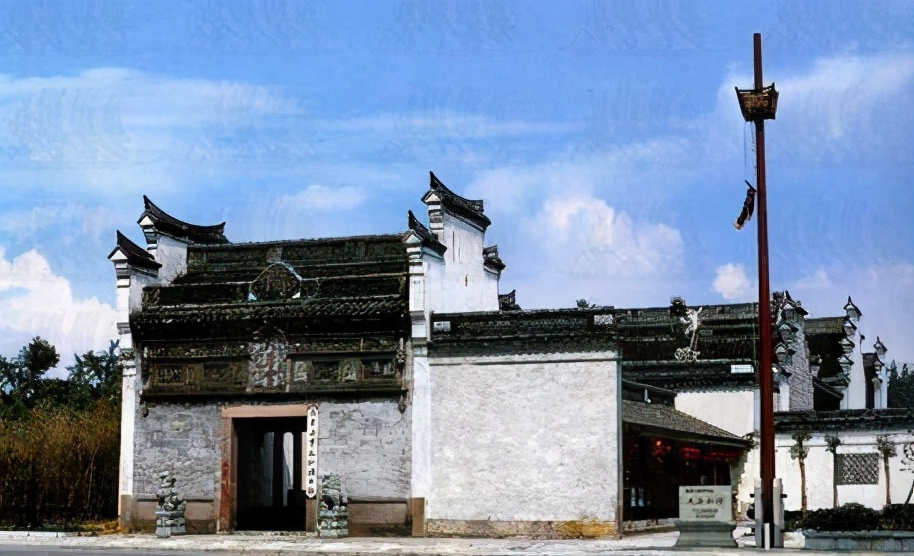
庆安会馆,位于浙江省宁波市区三江口东岸。为甬埠行驶北洋的舶商所建,始建于清道光三十年(1850年),落成于咸丰三年(1853年),既是祭祀天后妈祖的殿堂,又是舶商航工娱乐聚会的场所。庆安会馆,是中国八大天后宫和七大会馆之一,又是江南现存仅存二处融天后宫与会馆于一体的古建筑群之一。
Qing'an guild hall is located in the east bank of Sanjiangkou, Ningbo City, Zhejiang Province. It was built by the shippers who drove the northern ocean in yongbu. It was first built in 1850 (the thirtieth year of Daoguang's reign in the Qing Dynasty) and completed in 1853 (the third year of Xianfeng's reign). It is not only a temple for worshiping emperor Mazu, but also a place for the shippers, businessmen, and aviation industry to have fun. Qing'an guild hall is one of the eight Tianhou palace and seven guild halls in China. It is also one of the only two existing ancient buildings in the south of the Yangtze River that integrate Tianhou palace and guild hall.
2001年6月,庆安会馆作为清代古建筑,被国务院公布为第五批全国重点文物保护单位,现改建为全国首家海事民俗博物馆,展出各个朝代的船模。建筑装饰采用砖雕、石雕和朱金木雕等宁波传统工艺,堪称宁波近代地方工艺之杰作,有着重要的历史文化价值。同时这里也有着丰富的旅游资源。
In June 2001, as an ancient building of Qing Dynasty, the Qing'an guild hall was announced as the fifth batch of national key cultural relics protection units by the State Council. Now it is the first maritime folk custom museum in China, displaying ship models of various dynasties. The building decoration adopts the traditional crafts of Ningbo such as brick carving, stone carving and Zhujin wood carving, which can be called the masterpiece of modern local crafts in Ningbo, and has important historical and cultural value. At the same time, there are rich tourism resources here.
2.特色看点 Outstanding Feature
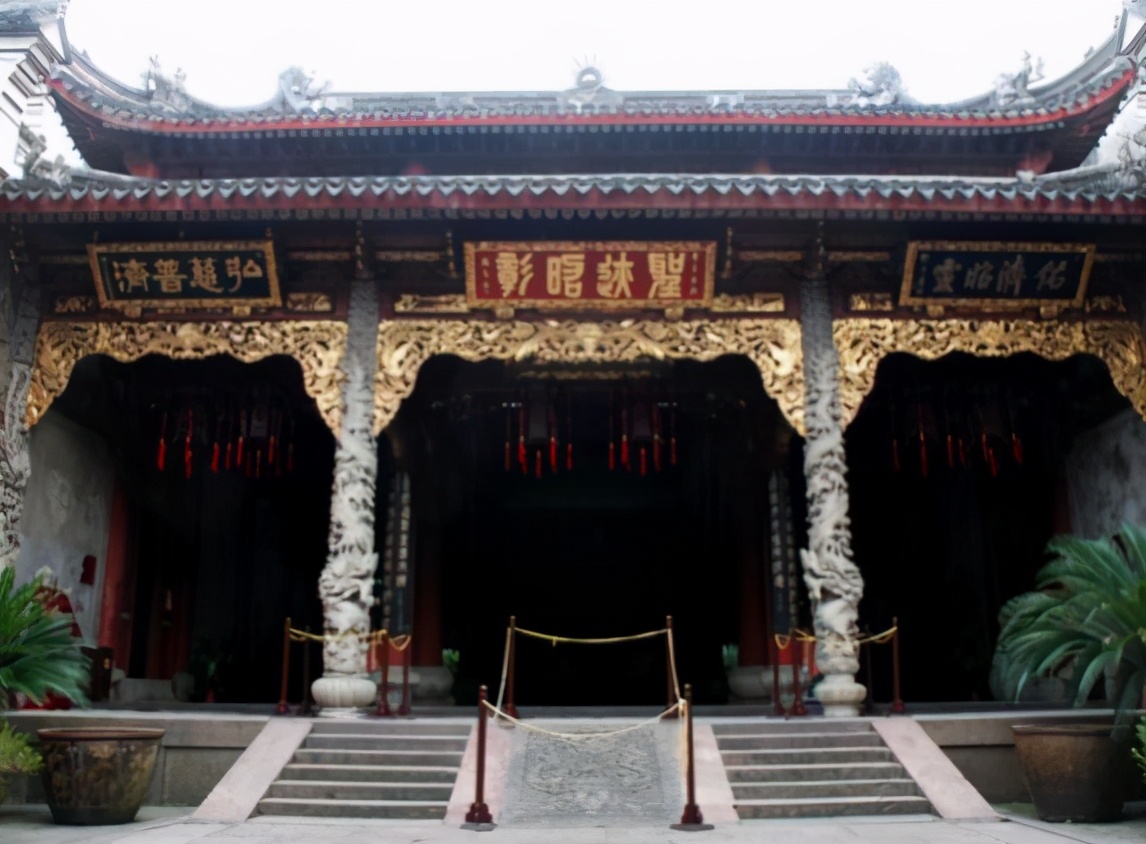
庆安会馆不仅有很高的观赏价值,而且为研究我国雕刻艺术提供了实物例证。其中,朱金木雕,主要使用在建筑各类构件上,以民间故事,戏曲人物为主,大多采用高浮雕和镂空雕相结合的工艺技法。经过油漆、贴金、拔朱、上彩,显得富丽堂皇、高贵典雅。庆安会馆建筑群座东向西,占地面积约3900平方米。大殿为庆安会馆的主要建筑,面宽为五开间,明间为拾梁式,次间为穿斗式。该建筑最大的特色是采用了宁波传统的朱金木雕,砖雕和石雕的建筑装饰手法,使整体建筑气势恢宏、金碧辉煌。匠心独用的砖雕、石雕和朱金木雕令人赞叹,堪称宁波地方工艺中的杰作。
Qing'an guild hall not only has a high ornamental value, but also provides a real example for the study of sculpture art in China. Among them, Zhujin wood carving is mainly used in various components of the building, mainly for folk stories and opera characters. Most of them adopt the combination of high relief and hollow carving techniques. After painting, gilding, drawing and coloring, it looks magnificent, noble and elegant. The building complex of Qing'an guild hall covers an area of 3900 square meters from east to west. The main hall is the main building of the Qing'an guild hall, with a width of five bays. The Ming hall is of the pick-up beam type, and the second hall is of the through bucket type. The biggest feature of the building is the use of Ningbo's traditional Zhujin wood carving, brick carving and stone carving architectural decoration techniques, so that the overall building momentum is magnificent, resplendent. The unique brick carving, stone carving and Zhujin wood carving are amazing, which can be called the masterpiece of Ningbo local crafts.
砖雕是庆安会馆建筑主要的装饰手法之一,主要分布在门楼和高大的马头墙上,雕刻的笔法细腻。画面充分运用我国传统的立体布局,众多的人物层次分明地并列于画面上,栩栩如生。内容丰富,大多选自民间传说和戏曲中的传奇人物如八仙、三星、九老等,还有花鸟动物等。大殿原系祀天后的神殿,高约10多米,明间和次间各有一对蟠龙柱,柱上倒挂式苍龙威风凛凛,张牙舞爪,这是采用镂空雕刻的形式,在整块的石料上一气呵成,现形体于青石之外,寓玲珑于浑厚之中,与此相呼应的凤、凰两柱也是采用这种雕法。梁、枋等构件上的朱金木雕,富丽堂皇,精美绝伦,充分显示着宁波工匠的聪明才智。
Brick carving is one of the main decoration methods of the Qing'an guild hall. It is mainly distributed in the gate building and the high horsehead wall. The carving technique is exquisite. The picture makes full use of the traditional three-dimensional layout of our country, and many characters are clearly arranged on the picture, vividly. It is rich in content, mostly selected from legends and opera legends such as eight immortals, three stars, nine elders, as well as flowers, birds, animals and so on. The main hall was originally the shrine for worshiping the queen of heaven, with a height of more than 10 meters. In the Ming Dynasty and the secondary period, there are two pairs of dragon columns. The inverted dragon on the column is majestic, with its teeth open and claws open. It is carved in the form of hollowing out. It is formed on a whole piece of stone. It appears outside the bluestone in the thick. The two columns of Phoenix and corresponding to this are also carved in this way. The Zhujin wood carvings on the beam, wood and other components are magnificent and exquisite, which fully shows the wisdom of Ningbo craftsmen.
起源于福建、也大盛于福建的天后宫即妈祖庙,在这里巍然屹立。其规模不亚于福建东山妈祖庙,因此又名“浙东海事民俗博物馆”。更配有电子设备,生动演绎妈祖的历史,为其他妈祖庙所独有。会馆的建筑,多为明清时期所造,典型的大殿大院气派,是清末宁波商帮行业聚会的场所。会馆内有来往于上海-宁波间的“江亚轮之舵”,沉没于1948年12月3日,罹难者多达2300余人,为世界海难之首。见到此舵,追怀往事,感慨万千。
The queen of Heaven Temple, or Mazu temple, which originated and flourished in Fujian, stands here. Its scale is no less than that of Mazu temple in Dongshan, Fujian Province, so it is also called "maritime folk custom museum in East Zhejiang". More equipped with electronic equipment, vivid interpretation of Mazu's history, unique to other Mazu temples. Most of the buildings of the guild hall were built in Ming and Qing Dynasties. The typical style of the hall and courtyard was the gathering place for the business guild of Ningbo in the late Qing Dynasty. There is a "rudder of Jiang Ya Lun" between Shanghai and Ningbo in the guild hall. It sank on December 3, 1948, killing more than 2300 people, making it the first shipwreck in the world. Seeing this rudder, recalling the past and feeling thousands of things.
3.历史传说 Legend
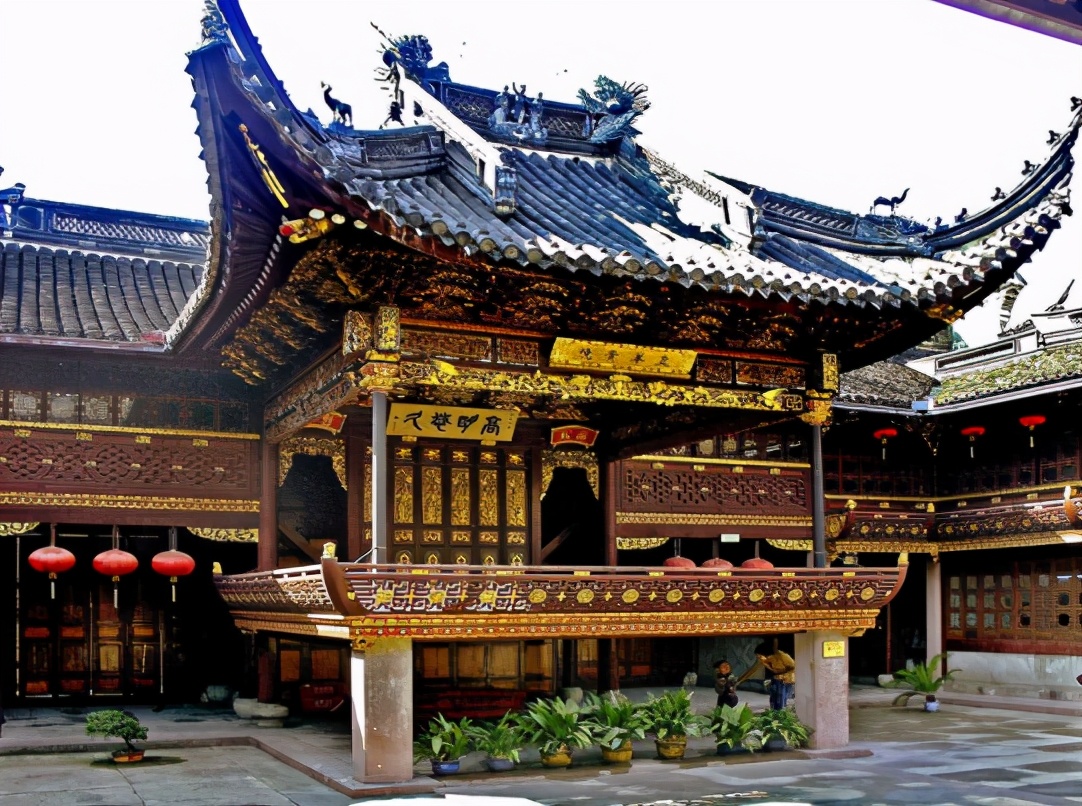
庆安会馆内的砖雕、石雕和朱金木雕珍品,具有重要的观赏价值,也为专家、学者研究中国江南清代道光与咸丰间的雕刻艺术提供了实物资料。庆安会馆是宁波港口城市的标志性建筑,是昔日宁波港与海外各国通商,贸易和友好往来的历史见证。
The brick, stone and Zhujin wood carvings in the Qing'an guild hall are of great ornamental value, and provide materials for experts and scholars to study the carving art between Daoguang and Xianfeng in the Qing Dynasty in the south of the Yangtze River. Qing'an guild hall is the landmark of Ningbo port city and the historical witness of the trade and friendly exchanges between Ningbo port and overseas countries in the past.
会馆内的四根龙、凤石柱的来历,还有一段故事:据说这四根石柱是特地请福建兴化的名师巧匠雕凿,历时一年余才成,要运回这每根高4米多、重数吨的石柱,可不是一件容易的事,船工巧动脑筋,未将其装入船舱内,而是悬装在帆船的船舷外侧,左右各置一柱,用绳索固定,四柱分装两船。当运至浙江洋面,忽遇飓风,涌急浪高,海洋上不少帆船被狂风刮翻船沉人溺,而两艘装有石柱的木船在惊涛骇浪之中因两舷挂装石柱,重力均衡,船体稳定,竟乘风破浪,得以安然无恙。平安到达甬江道头,舶商、船工认为是天后圣母佑灵,于是在会望门前,搭起戏台,演戏三天,如敬神灵,江东顿时热闹非凡,传为佳话。
There is also a story about the origin of the four Dragon and Phoenix stone pillars in the guild hall. It is said that the four pillars were specially carved by skilled craftsmen from Xinghua, Fujian Province. It took more than a year to finish. It's not easy to transport each stone pillar with a height of more than 4 meters and a weight of several tons. The boatmen used his brain skillfully and didn't put it into the cabin, but hung on the outside of the ship's side, with one pillar on each side, It is fixed with ropes, and the four pillars are divided into two ships. When it was transported to the sea of Zhejiang Province, there were hurricanes and strong waves. Many sailboats were capsized by the strong wind and drowned. However, two wooden boats with stone pillars were able to ride the wind and break through the waves because of the balance of gravity and stability of the hull. When they arrived at the wharf of Yongjiang safely, the shippers and boatmen thought it was the Blessed Mother of the queen of heaven, so they set up a stage in front of the meeting gate and acted for three days as they respected the gods. Jiangdong district was immediately bustling with this good news.
浙江省社科联社科普及课题成果
课题编号:19ZC07
课题名称:2022,千年宁波欢迎你(迎亚运宁波旅游双语读本)
负责人姓名:单春昕
工作单位:宁波大红鹰学院